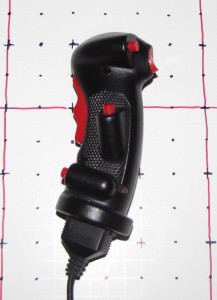Electric Curiosities: Motion Sensitive Controllers
The PS3 has one that, much like the system itself, no one cares about.
The Wii built their entire reason for existing around one.
And the XBox 360 has decided that they’re completely irrelevant, and is instead trying to pass off an EyeToy rip-off as “Innovation”.
I’m talking about motion sensitive controllers, and despite what Nintendo ((And Apple, for that matter.)) might have you believe, they’re about as innovative as Project Natal. You see, the Wii isn’t the first Nintendo system to have a motion activated joystick.Â
 The NES had one, called the “Game Handler”, from IMN Control. The Game Handler is basically the top half of a flight stick, without that whole pesky base that’s normally attached. The product code for this joystick is the overly optimistic “GH-001”, implying that not only were they expecting the line to produce a GH-002 and GH-003, but also a GH-100.
I have one. Unfortunately, my apparently gargantuan hands are unable to comfortably hold the controller in such a way that I can press all of the buttons without finger contortions. The main trigger and the primary thumb button are interchangable between A and B, while the two difficult to reach, yet remarkably in the way side buttons are start and select. They’re unlabeled, but that’s not a problem, because you’ll accidentally hit one of them rather frequently when you play, so you’ll soon learn which one is which.
Of course, Game Handler itself was not terribly innovative. The Atari 2600 even had a gravity controller, and I think it used real mercury switches, because it’s from back before mercury was dangerous. I’ve seen it called “Le Stick” or the “Heyco Gravity Joystick”. The joystick itself says “Heyco” on a small ring where the cord enters the base, but the plug appears to have been harvested off of a regular Atari joystick.  Although it’s decidedly phallic in appearance ((Thankfully it was released before controllers had a rumble feature…)), it’s much easier to hold this joystick than the Game Handler. Much of the simplicity is owed to the fact that it only has one button, and that button can be placed on the top, where it’s easy to press.Â
Thing of it is, this joystick is digital. That means it’s on/off. Which means you’re either tilted or not. There’s no clear indication of when you’re about to tilt far enough to trigger the switch. And it’s inconsistent. Sometimes left will move you left, sometimes it will move you left and up, and sometimes down. Just down. Not left and down. Just… Down. Down doesn’t move you down. Down moves you right. Of course. That means you play like you’re having a seizure.
[mediaplayer src=’/log/wp-content/uploads/2009/09/YarsRevengeGravity.wmv’ autoLoad=1 width=448 height=336 ]
I don’t normally suck that much at Yars’ Revenge.
Now, that much awesome simply cannot exist on its own. When you have an object this amazing, well, you just have to get two.
Next up:Â Robotron 2084.
So, in the end, it’s clear that the motion control of today’s consoles is not nearly as technologically innovative as you were led to believe. It had all been done before, nearly 30 years ago. The innovation made with this generation was that the designers decided that it would be a good idea to remove the suck from motion controllers and make something that actually worked.





1 comment
I had one of these, possibly intended for a Sega system since it had the 9 pin D connector instead of the NES plug. Another feature on mine was the cord was removable from the stick. Of course I took mine apart to see what was inside. Switches, wires and four mercury tilt switches in the bottom end. No electronic bits or chips did I see. I wonder if the bulky bit on the bottom of yours is removable and/or contains the electronics to make it sympatico with the NES? IIRC mine was blue with lighter blue buttons.
Leave a Comment